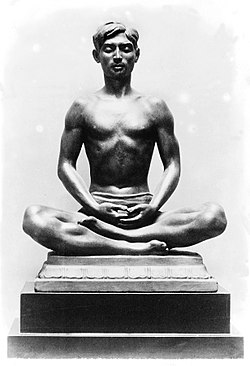Annapurna Upanishad
| Annapurna Upanishad | |
|---|---|

The Upanishad discusses meditation and spiritual liberation
|
|
| Devanagari | अन्नपूर्णा |
| IAST | Annapūrṇā |
| Title means | Abundance of food |
| Type | Samanya (general) |
| Linked Veda | Atharvaveda |
| Chapters | 5 |
| Verses | 337 |
| Philosophy | Vedanta |
The Annapurna Upanishad (Sanskrit: अन्नपूर्णा उपनिषद्, IAST: Annapūrṇā Upaniṣad) is a Sanskrit text and one of the minor Upanishads of Hinduism. It is classified as a Samanya Upanishads and attached to the Atharvaveda.
The text is structured into five chapters, as a discourse between yogin Nidagha and Vedic sage Ribhu. The first chapter presents a series of questions such as "Who am I? How did the universe come about? what is the meaning of birth, death and life? what is freedom and liberation?" The text then discusses its answers, after attributing the knowledge to goddess Annapurna.
The text is notable for describing five types of delusions, asserting the Advaita Vedanta doctrine of non-duality and oneness of all souls and the metaphysical Brahman, defining spiritual liberation as being unattached to anything and freedom from inner clingings. The text describes Jivanmukti – achieving freedom in this life, and the characteristics of those who reach self-knowledge.
The author and the century in which Annapurna Upanishad was composed is unknown. Manuscripts of this text are also found titled as Annapurnopanisad. This Upanishad is listed at number 70 in the Telugu language anthology of 108 Upanishads of the Muktika canon, narrated by Rama to Hanuman.
The text consists of five chapters, with a cumulative total of 337 verses.
The text opens with yogin Nidagha meeting the one who knows Brahman, the Vedic sage Ribhu, paying respects and then asking, "teach me the truth about Atman (soul, Self)". Ribhu begins his answer, in verses 1 to 12, by disclosing the source of his knowledge, which he attributes to goddess Annapurna, calling her the ruler of the world, the goddess of fulfillment, desire and humanity. Ribhu states that he reached the goddess using the prayers developed by the group of female monks. After many days of prayers, states Ribhu, the goddess Annapurna appeared, smiling. She asked him what boon he wanted, and Ribhu replied, "I want to know the truth about soul". The goddess just vanished, giving him silence, and the introspection in this silence, states Ribhu, revealed him the Self-knowledge.
...
Wikipedia
